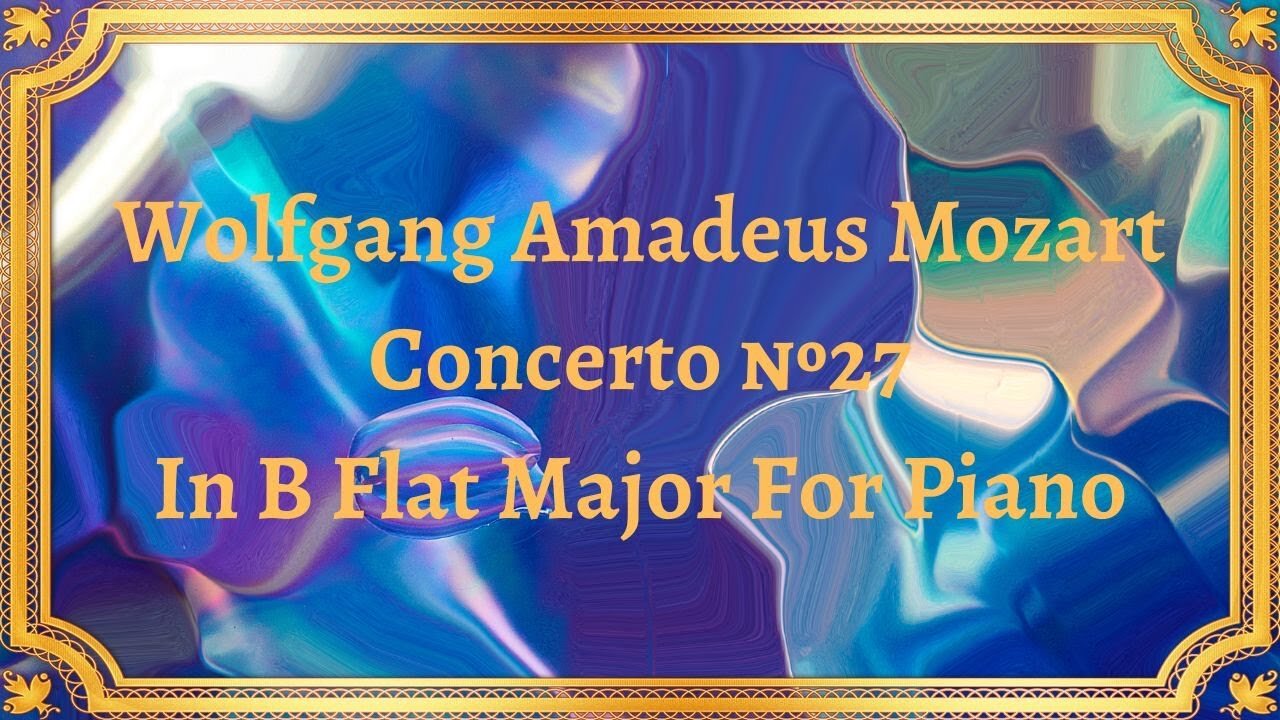Premium Only Content

Wolfgang Amadeus Mozart Concerto №27 In B Flat Major For Piano
#WolfgangAmadeusMozart #ConcertoNo27 #BFlatMajor #piano #classicalmusic #musicalcomposition #Austriancomposer #pianoconcerto #classicalperiod #virtuosity #melodicbrilliance #musicappreciation #composer #musictheory #pianomusic #musicperformance
Publication date 1951
Mieczyslaw Horszowski, Piano, with the Perpignan Festival Orchestra, Pablo Casals, Conductor
"Wolfgang Amadeus Mozart Concerto No. 27 in B Flat Major for Piano" is a remarkable musical composition by the Austrian composer Wolfgang Amadeus Mozart. This concerto, written during the classical period, showcases Mozart's exceptional talent for crafting captivating and virtuosic piano music.
Composed in 1791, near the end of Mozart's life, Concerto No. 27 in B Flat Major is a testament to his mastery of the piano concerto genre. It is one of Mozart's last compositions in this form and is considered a pinnacle of his creative output. The concerto consists of three movements: Allegro, Larghetto, and Allegro.
The first movement, Allegro, immediately captivates the listener with its energetic and lively character. It begins with a majestic orchestral introduction, followed by the entrance of the piano with a dazzling and virtuosic solo passage. The movement showcases Mozart's signature style, with its impeccable balance between the piano and the orchestra, allowing both to shine. The music is filled with melodic brilliance, intricate ornamentation, and masterful use of dynamics, creating a sense of drama and excitement.
The second movement, Larghetto, offers a contrasting mood to the lively first movement. It is a tender and lyrical episode that showcases Mozart's gift for crafting beautiful melodies. The piano takes center stage, expressing heartfelt emotions through its expressive lines. The orchestra provides a delicate and supportive accompaniment, creating a sense of intimacy and introspection. This movement is a testament to Mozart's ability to evoke deep emotions through his music.
The final movement, Allegro, returns to the energetic and spirited nature of the concerto. It is a lively and joyful culmination of the musical journey. The piano and the orchestra engage in a dynamic dialogue, exchanging musical ideas and showcasing the virtuosity of the pianist. The music is characterized by its playful and lively rhythms, intricate passages, and moments of musical brilliance. It concludes the concerto with a sense of triumph and exuberance.
"Wolfgang Amadeus Mozart Concerto No. 27 in B Flat Major for Piano" stands as a testament to Mozart's exceptional talent as a composer and his ability to create music that is both technically challenging and emotionally captivating. It represents the pinnacle of classical-era piano concerto writing, with its melodic brilliance, virtuosic passages, and seamless integration of the piano and orchestral elements.
This concerto continues to captivate audiences and musicians alike, showcasing Mozart's timeless genius and his ability to transcend the boundaries of time and place. Its enduring popularity and ongoing performance attest to its significance in the classical music repertoire.
In conclusion, "Wolfgang Amadeus Mozart Concerto No. 27 in B Flat Major for Piano" is a masterpiece of the classical period. Through its three captivating movements, Mozart's genius shines brightly, showcasing his exceptional talent for crafting melodic brilliance and virtuosic piano passages. This concerto remains a beloved and cherished part of the classical music canon, captivating audiences with its beauty, technical brilliance, and emotional depth.
You have the opportunity to support the channel https://destream.net/live/RadSiarAl/donate
-
 1:57:39
1:57:39
The Charlie Kirk Show
2 hours agoThe Fake Tulsi Smear + Is Canada a Free Country? (No) + Why Trump Is Winning | Mullin | 11.25.24
49.6K18 -
 27:42
27:42
Stephen Gardner
2 hours ago🔥Blackmail Scheme ROCKS Trump's RFK Pick!
6.32K29 -
 59:57
59:57
The Dan Bongino Show
6 hours agoGeraldo Wants To Fight Me Again? (Ep. 2377) - 11/25/2024
657K2.3K -
 1:06:06
1:06:06
The Rubin Report
3 hours agoBill Maher Makes Neil deGrasse Tyson Go Silent with His Proof of Failing Science
57.7K65 -
 1:15:38
1:15:38
Geeks + Gamers
3 hours agoDisney Still HIDING Snow White Trailer After Rachel Zegler BACKLASH, Wicked And Gladiator Box Office
35.2K5 -
 1:57:01
1:57:01
Steven Crowder
5 hours agoWill The Left Use The Ukraine War to Sabotage Trump's Presidency?
334K202 -
 LIVE
LIVE
Game On!
2 hours agoCollege Football Playoffs CANCELED! | Crick's Corner
101 watching -
 38:00
38:00
Tudor Dixon
4 hours agoDudes Shouldn't be in Women's Bathrooms | The Tudor Dixon Podcast
28.6K10 -
 16:27
16:27
Dave Portnoy
5 hours agoDavey Day Trader Presented by Kraken - November 25, 2024
69.2K3 -
 1:27:43
1:27:43
Graham Allen
6 hours agoJoe Rogan Warns The World About WWIII! Make Military Great Again! + Elon Is Buying MSNBC?!
105K145